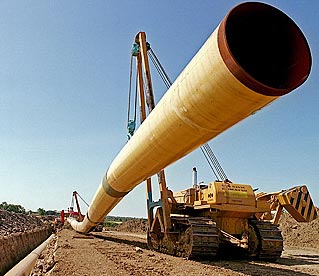
Turkmenistan Encourages Trans-Caspian Gas Pipeline
Publication: Eurasia Daily Monitor Volume: 7 Issue: 221
By:

Framework agreements on a Turkmenistan-Afghanistan-Pakistan-India pipeline (TAPI) are scheduled for signing by high-level officials of the four countries on December 11 in Ashgabat (Turkmen Television, Press Trust of India, December 8, 9). Its economics and its political symbolism aside, TAPI’s implementation is hardly conceivable on the territory of Afghanistan as long as war conditions prevail there.
Meanwhile, publicity around the TAPI signing event may divert attention from a more significant, but less publicized recent development. On November 18-19, Turkmenistan offered to deliver 40 billion cubic meters (bcm) of gas annually to Europe by pipeline across the Caspian Sea, linking up via the South Caucasus to the Nabucco project.
President Gurbanguly Berdimuhamedov and First Deputy Prime Minister Baymurat Hojamuhamedov aired overlapping elements of this message publicly, within one day of each other. The Turkmen offer’s large volume is unprecedented. Its implied timeline is 2015. The link with Nabucco is stated explicitly.
For the first time after years of ambiguity or outright silence, Turkmenistan now speaks up explicitly for a trans-Caspian pipeline. The original Trans-Caspian Gas Pipeline Project (TCGP) had been planned by Bechtel, General Electric, and Royal Dutch Shell during the late 1990’s, for a total capacity of 32 bcm per year, in two stages of 16 bcm each (the first stage was planned to supply Turkey, the second was envisaged for Europe). However, that project lost out to Gazprom in a race for the Turkish market by 2001. Western support dissipated after that, and Russia intimidated Turkmenistan into silence about a trans-Caspian pipeline until now. Thus, Turkmenistan’s bold proposal, after all these years to reactivate this project, is a landmark event.
The message came in two parts. First, in his speech at the summit of five Caspian States on November 18 in Baku, Berdimuhamedov asserted that underwater pipelines in the Caspian Sea should be built with the consent of only those countries whose territorial sectors would be traversed by such pipelines. This means that Turkmenistan asserts its right to link up with Azerbaijan through a seabed pipeline.
Azerbaijan had been the lead country all along in promoting this principle. Russia (with Iran in tow) claims on the contrary that any trans-Caspian pipeline projects require the consent of all riparian countries, implying a Russian veto. Thus, Berdimuhamedov contradicted Moscow’s position in the presence of Russian President, Dmitry Medvedev, at the Caspian summit in Baku (Interfax, Turkmen Television, November 18).
On November 19 in Ashgabat, First Deputy Prime Minister, Hojamuhamedov, delivered the second part of the message. Addressing the Oil and Gas of Turkmenistan-2010 international forum, he offered 40 bcm per year for a trans-Caspian pipeline to Azerbaijan, with a continuation link to Nabucco. Of that volume, 30 bcm would originate from the supergiant South Yolotan and South Osman fields in Turkmenistan’s east, to be delivered at the Caspian shore through the planned East-West Pipeline across Turkmenistan. Another 10 bcm would originate from Turkmenistan’s offshore fields, he said. Of this volume, Turkmenistan is ready to sell 5 bcm of gas per year as of 2011, from the first phase of production at offshore Bloc 1, operated by Petronas.
According to Hojamuhamedov, export commitments already assumed by Turkmenistan in other directions have been factored into this calculation. The 40 bcm per year for trans-Caspian delivery come on top of Turkmenistan’s other export commitments and its internal requirements. Thus, “European countries should not worry [about gas supplies]” (Interfax, EurasiaNet, November 19).
The implied target date is 2015, when the Turkmen East-West pipeline is due to reach the country’s Caspian shore, premised however on availability of a trans-Caspian outlet by that date. The offer also evidences Turkmenistan’s readiness to supply several pipeline projects within the EU-backed Southern Gas Corridor to Europe, of which Nabucco is the main one. Nabucco’s maximum capacity of 31 bcm per year is to be filled from several producer countries, including Azerbaijan and Turkmenistan. Thus, Nabucco can only accommodate a limited portion of Turkmen gas volumes projected for export to Europe post-2015. Turkmenistan’s 40 bcm per year proposal amounts to an encouragement, both for Nabucco’s second stage and for the Southern Corridor generally.
This offer is consistent with recent moves, statements, and signals by Ashgabat. In June of this year, Turkmenistan commissioned the construction of its East-West pipeline, due for completion by 2015, at an estimated cost of $2 billion, entirely from the state budget (EDM, June 8). On September 16, Berdimuhamedov declared (during a Turkic states’ summit in Istanbul) that the pipeline is intended to link up with the Nabucco project. This goal had been implied, but Berdimuhamedov made it explicit and public (EDM, September 17, 21). The trans-Caspian pipeline was also implied, but it has now been stated openly with the November 18-19 statements.
Given Ashgabat’s habitual reluctance to tip its hand publicly or irritate Moscow through unnecessary announcements, these statements are major milestones. They await a more effective Western response than was the case in 2001.




